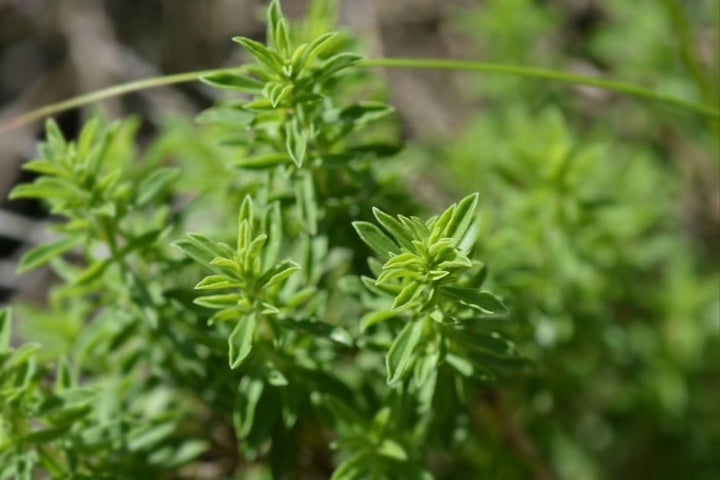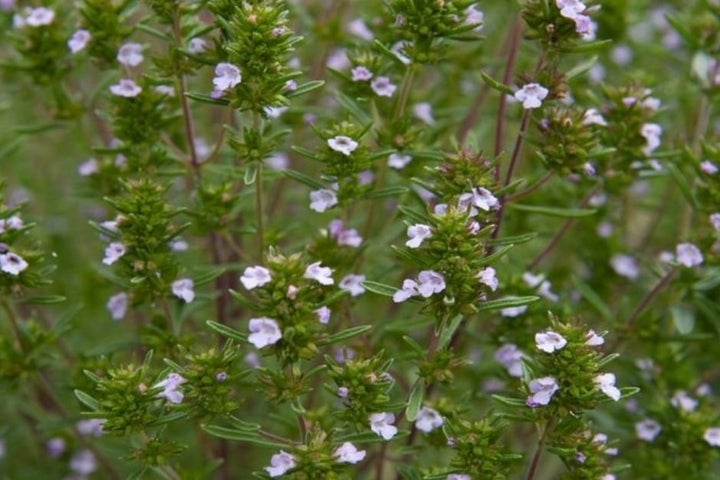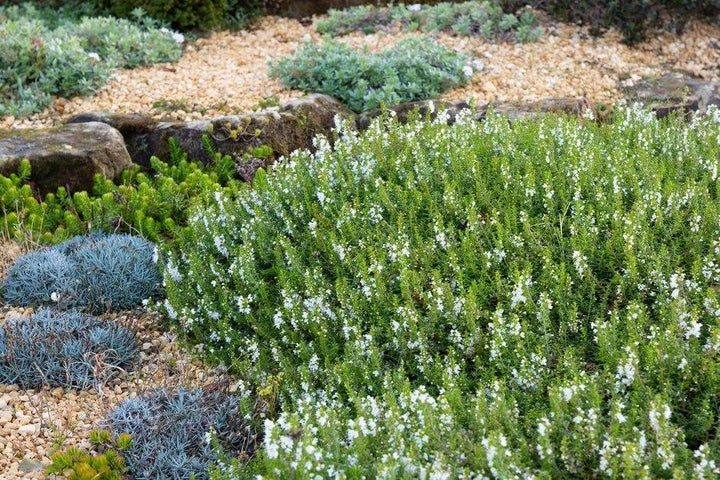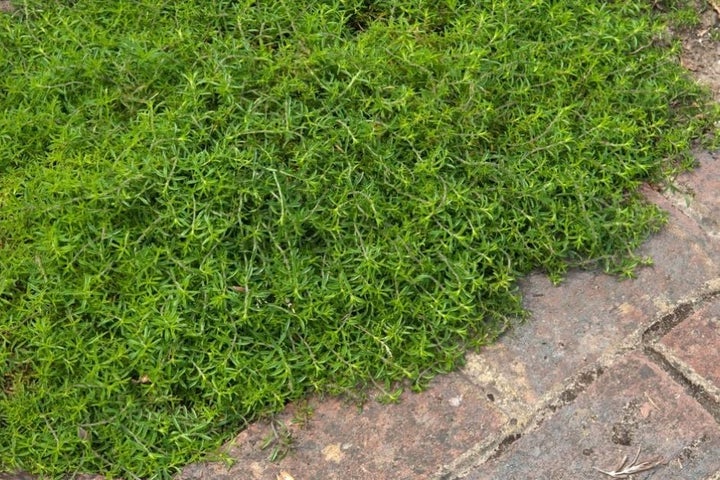Getting Started
Savory is not a widely known herb, but its small, peppery-tasting leaves have many culinary uses. It’s not generally sold in supermarkets, so the best way to enjoy it is to grow your own. There are three main types of savory – annual summer savory (Satureja hortensis) and two evergreen , winter savory (S. montana) and creeping savory (S. spicigera).

Savory is easy to grow and will thrive in full sun and free-draining conditions, in the ground or in containers. These attractive small plants take up little space and are ideal for growing alongside other sun-loving herbs, such as rosemary, thyme and sage, in a herb garden, raised bed or container. The narrow, aromatic leaves have a peppery, slightly spicy flavour and are said to aid digestion. They are often used in bean and lentil dishes, and are a traditional flavouring in stuffings and sausages. Summer savory is also a key ingredient in herbes de Provence. The tiny white or mauve summer flowers are a good source of nectar for bees.
Jobs to do now
Harvest
Month by Month
Sow
Plant
Harvest
Choosing What To Grow

The three main types of savory are all compact plants with small narrow leaves. The main differences between them are harvesting period, strength of flavour and how long they live.
Summer savory (Satureja hortensis) – this is an annual, so lives for just one summer. It’s usually sown in spring and harvested from mid-summer until it dies off in autumn. It forms a bushy plant about 30cm (1ft) tall and wide. The leaves have a milder, more delicate flavour than winter savory and are harvested over a shorter period.
Winter savory (Satureja montana) – this is a , so lives for several years. A shrubby plant up to 40cm (16in) tall. It's hardy but semi-evergreen, meaning it will shed it's leaves during very cold weather. However, in milder regions it will keep its leaves through winter, so they can be picked all year round. The leaves have an earthy, spicy, peppery flavour.
Creeping savory (Satureja spicigera) – a low-growing perennial herb about 10cm (4in) tall, with a spread of about 30cm (12in). Hardy throughout most of the UK. The tiny leaves are highly aromatic with a strong spicy flavour.
For inspiration on choosing all kinds of herbs, visit the RHS gardens, where you’ll be able to see and smell a wide array of aromatic and richly flavoured herbs, and pick up useful growing tips.
What & where to buy
You can buy seeds of summer and winter savory in some garden centres and from online seed suppliers, particularly herb specialists. Young savory plants may be available in spring and summer from the same sources, although creeping savory may be harder to track down.
Buying young plants is often a more convenient option than growing from seed, especially if you’re short on indoor sowing space, as you don’t need many plants to ensure plentiful harvests.
Recommended Varieties

Creeping savory
Satureja spicigera – low-growing habit. Strongly flavoured evergreen leaves. White flowers.

Summer savory
Satureja hortensis – an annual herb. Narrow, aromatic leaves with a mild flavour.

Winter savory
Satureja montana – semi-evergreen herb. Highly aromatic leaves. Mauve or white flowers.
Sowing
Seeds can be started indoors in spring. Sow thinly onto the surface of pots or modular trays filled with moist peat-free , there is no need to cover the seeds with . Then place in a or cover with a clear plastic bag and leave them somewhere bright, such as a sunny windowsill. Seeds germinate well at around 20°C (68°F).
should appear within two to three weeks. When they have several leaves, move them into individual pots or larger . Keep seedlings in warm, bright conditions and water regularly, but take care not to overwater as seedlings are prone to damping off. They can be planted outside once they’re well rooted and growing strongly (see Planting below).
Planting

Savory is best planted outside in spring, once the soil is starting to warm up. Indoor-grown plants, raised from seed or cuttings, should be acclimatised to outdoor conditions by hardening off before being planted out.
Planting in the ground – choose an open, sunny planting spot with free-draining soil that never gets . If your soil is heavy or stays damp, plant in a raised bed or a container instead, to provide better drainage. Plant savory at the same depth it was previously growing and at least 20cm (8in) from neighbouring plants.
Planting in a container – choose a pot that’s at least 20cm (8in) wide and deep, and make sure there are plenty of drainage holes in the base. Fill it with peat-free and mix in some horticultural grit (up to 25 per cent by volume) to improve drainage. Position the container in a warm, sunny spot.
Plant Care
Savory is easy to grow and needs little maintenance, apart from watering in dry spells when newly planted or grown in a container. Harvest regularly to keep plants producing lots of fresh new leaves.
Watering
Savory is fairly drought tolerant but new plants should be watered during dry spells in their first year. Once established, savory shouldn’t need additional watering when growing in the ground. Plants in containers will need some additional water during dry spells as the can dry out quickly in hot, dry, sunny weather, but never let the compost get .
Feeding
Savory growing in the ground doesn’t need feeding and should thrive even in poor soil. However, plants that have been growing in the same container for more than one year will benefit from a sprinkling of general purpose granular feed in late spring or early summer.
Winter protection
Winter savory and creeping savory are hardy throughout most of the UK but their growth will slow down as temperatures and light levels drop. If you want fresh leaves to harvest during winter, move potted plants into a bright, cool but frost-free place, such as a greenhouse or porch. Given sufficient light and warmth, they will continue producing new leaves.
In winter, excess rain can cause the roots to rot, so move plants in containers to a sheltered spot, such as in the rain-shadow of a wall. In high-rainfall regions protect savory plants in the ground with cloches, but ensure they have good .
Summer savory is an annual so will die in autumn – the plants and grow new ones from seed the following spring.
Propagating
You can grow savory from seed (see Sowing above). If plants, or sections of them, are left to flower and set seed, you can collect seeds for sowing the following spring. This is especially useful for summer savory, as it is an annual and you'll need new plants each year. In favourable conditions, savory may self-seed.
Winter savory and creeping savory can be propagated by taking softwood cuttings from new growth in summer. You can also layer plants in spring or autumn by pegging low stems into the soil to root. This often happens naturally, especially with creeping savory, so check for rooted stems around the edge of your plant and pot them up.
Pruning And Training
Regular harvesting of the shoot tips will keep savory plants compact and encourage fresh new growth. Trim back summer savory after flowering to get a flush of new shoots for harvesting into autumn. Remove the faded flower stems of winter savory and creeping savory to keep plants looking tidy, but leave some if you want to collect seeds. Winter savory can become straggly over time, so prune lightly in mid- to late-spring to keep plants compact and bushy.
Harvesting

Harvest savory’s leafy shoots and use them fresh for the best flavour. You can start harvesting lightly from plants grown from seed once they reach about 10cm (4in) tall. Savory leaves have a rich, spicy, peppery flavour. To use fresh leaves in the kitchen, strip them from the stems, then chop finely. Leaves can also be dried for later use – hang up sprigs in a warm, dark, well-ventilated place. When fully dried, store the leaves in an air-tight jar. They can be added to a range of dishes, including beans, lentils, soups and stews.
The leaves of summer savory have a more delicate flavour and taste slightly fresher and sweeter before plants start flowering. Cutting back plants after flowering usually allows time for a second flush of leaves that can be harvested into autumn.
Winter savory and creeping savory can be harvested for most or even all of the year. Although, growth will slow down or stop over winter. If you want to continue harvesting fresh leaves through winter, grow plants in pots and move them somewhere bright, cool but frost-free.
Problem Solving
When grown in warm, sunny, well-drained conditions, savory plants are generally healthy and trouble free. Winter savory and creeping savory should live for several years, while annual summer savory will naturally die off in autumn and should be sown afresh every spring.


